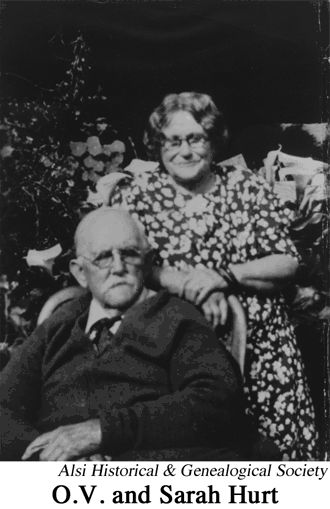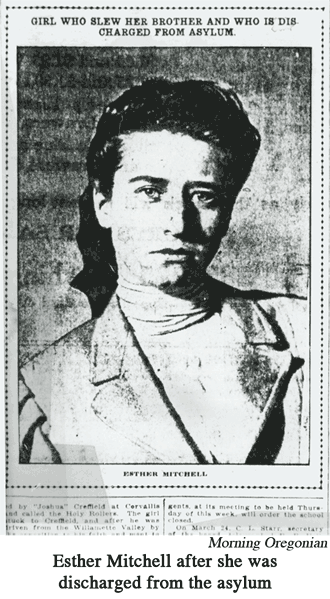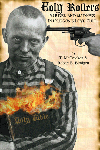Holy Rollers: Murder and Madness in Oregon's Love Cult
by T. McCracken and Robert B. Blodgett
CHAPTER THIRTY
Final Chapter
***
Every place that the sole of your foot shall tread upon, that I have given it unto you, as I said unto Moses
Joshua 1:3
***
 Shortly after
Esther was committed to the asylum, O. V. and Sarah Hurt moved to Waldport,
where they bought a nine-room house with a beautiful garden on the Alsea Bay. After
Maud's death, Sarah's health continued to deteriorate, and O. V. hoped that
moving to the coast would help her--which it did.
Shortly after
Esther was committed to the asylum, O. V. and Sarah Hurt moved to Waldport,
where they bought a nine-room house with a beautiful garden on the Alsea Bay. After
Maud's death, Sarah's health continued to deteriorate, and O. V. hoped that
moving to the coast would help her--which it did.
Soon thereafter, with his wife Hattie, Clarence Starr, one of Sarah’s brothers, also moved to Waldport. When Sarah, Clarence, Hattie, Hattie’s brother Edwin Baldwin, and Edwin’s wife Victoria were children, their families were neighbors on the Alsea Bay. In fact, Victoria’s parents, David and Orlena Ruble, are considered to be the founders of Waldport. In 1884, David, having no transit, used the stars as his guide when he laid out the town’s streets on a sand spit that had once been an Indian burial ground. Graves could be found everywhere, and it wasn't uncommon for people to overturn rocks with their feet and discover that the rocks were actually human skulls.
O. V. also bought the Hosfords’ homestead, across the Yachats River from where Creffield had hoped to establish his new Eden. The town of Yachats is laid out on this land. Eventually almost everyone connected with the Holy Rollers moved either there or to Waldport, eight miles to the north.
O. V.’s daughter Mae--his “little girl”--married a man named Frank Johnson. They bought a hotel in Yachats that had been owned by John Silvers, “a big fellow with big ideas,” who sold part of Yachats, although he didn't own an inch. He salted a gold mine in town, but when the gold ran out, so did he--leaving almost as fast as Creffield had. Frank Johnson died in 1950 at the age of seventy-one, and Mae Hurt-Johnson died in 1980 at the age of ninety-four.
When the road to Cape Perpetua was being built in 1912, Mae and Frank’s hotel was filled to capacity with twenty-eight boarders, and many slept in cabins behind it. Burgess Starr, who eventually divorced Donna, did the cooking for the road crew. Burgess died in 1936 at the age of sixty-five. "Providence did not always light his pathway as he most desired," his obituary said, "yet he had a happy faculty of seeing the bright side in everything and had a good word for all."
Frank Hurt died in 1920 at the age of thirty-seven while laying a line of traps on a stream with Frank Johnson. The two were a short distance apart when Johnson heard a single shot from Hurt's direction. He assumed Hurt had killed an animal he’d found in a trap. When Johnson came back and couldn't find his brother-in-law, he walked down the stream and found him dead, a bullet through his head. The Coroner ruled that "Hurt came to his death from the accidental discharge of his gun.”
Ten years later, in 1930 Mollie Hurt (neé Sandell) married James Berry. When James had returned to Corvallis in 1906 after testifying before Esther and Maud’s sanity hearing, he walked into his wife Clara’s room and found her trying to kill herself by swallowing carbolic acid. The two soon thereafter divorced. James insisted on taking custody of their son, Kenneth; then, instead of taking care of the boy himself, gave him to O. V. and Sarah Hurt to raise.
James then wed a woman by the name of Tensie Johnson. That marriage didn’t last long, and in 1916 he married Donna Starr, and the two of them ran a store in Yachats. Their marriage wasn't happy either. James drank heavily and, when drunk, was abusive. One of the worst nights was Christmas Eve of 1917. “He came home drinking, the town is ten miles from our place,” Donna said. “He had some meat smoking in the smoke house; he left the little boys to keep up the fire; they burnt the meat and he blamed me for it, cursing and swearing and beat me.”
James hit her in the head several times. He then knocked over the chair she was sitting in, breaking the chair and severely bruising her. “It was because I had let the meat burn, I didn’t know anything about it,” Donna said.
On another occasion he tried to choke her. “I ran in between them to separate them,” said Rachel, Donna’s oldest daughter. “He started to choke her and beat her up; I talked to him a long time; then he went in the store and got another drink and came back, and kept that up all night.”
“I was unnerved,” Donna said. “I wasn’t like myself. I nearly had a nervous prostration several times, nervous breakdown. . . . With tears in my eyes, I begged and begged, it was the same thing over.” The two divorced in 1919. Donna died in 1947 at the age of sixty-seven.
A year after his divorce from Donna, James married a Christian Scientist, Alice Kent. It was another disastrous marriage. He drank more heavily than ever, remaining drunk for days at a time, and frequently threatened to kill both himself and Alice. In 1925 he had a glandular operation “for the purpose of rejuvenating him sexually and renewing his youth sexually.” Afterwards, his sexual appetite was insatiable. When it was more than Alice could take, he told her that he could “only live with a woman just so long” and for her to get out and go. At the time he was also seeing a married woman. “If he has incurred debts and failed to pay his taxes,” Alice said when filing for divorce in 1927, “it is because he has wasted his money upon other women and upon intoxicating liquor.”
James Berry was still married to Mollie when he died in 1943 at the age of sixty-five. Mollie died in 1959 at the age seventy-eight. She is buried next to Frank Hurt, and her headstone says, “Mollie, wife of Frank Hurt.”
One of Mollie and Frank Hurt’s children, Virginia Esther, married James Berry's son Kenneth. Virginia Esther died of influenza in 1931 at nineteen. Kenneth Berry, whose father had been the first man to have an automobile in Corvallis, died at the age of twenty-six in an automobile accident nine months after his wife's death.
Ruth, Frank and Molly Hurt’s baby who was one of those rescued from Creffield’s coastal camp, died in 1999 at the age of ninety-three.
Lewis and Cora Hartley eventually reconciled, and after losing a fortune in mining claims in the Bohemia District, they too moved to Yachats. Lewis died in 1937 at eighty-three, and Cora died in 1945 at eighty-six.
Warren Hartley and his wife, Aileen, moved to Newport, fourteen miles north of Waldport. Warren was a funeral director there and was terribly busy when influenza swept through the country after World War I. His only son, Vernon LaMar--Cora Hartley’s grandson whom she had “damned everlastingly” in 1906--was one of the many local victims, dying in 1919 at the age of fourteen. In 1933, at the age of fifty, Aileen, a Christian Scientist, died after a long illness. Warren died in 1959 at the age of seventy-six.
In 1910 Sophie Hartley became the Yachats postmistress and ran a store. In 1913 in the Hurts’ home, she married George Mitchell’s brother, Perry. Perry became a mail carrier. He died in 1961 at seventy-six, and Sophie died in 1970 at eighty-seven. They are buried in the Yachats Cemetery, not in the Mitchell family plot in Newberg. In 1906, when Perry was trying to raise money to take George Mitchell’s body back to Oregon, he said: “George ought to be buried beside his mother. There's a lot there and there's room enough for us all in it, and I think that's where we all ought to be when our time comes.” George was the last Mitchell buried there.
Phoebe Mitchell-Vander Kelen and her husband Peter had one child, whom they named Charles, presumably after Phoebe’s father, Charles Mitchell. Phoebe died in 1909 when, during an epileptic seizure, she dislocated one of her cervical vertebrae. She was thirty-three. Peter Vander Kelen left the Salvation Army, remarried, and became a city street cleaner in Portland. He died of tuberculosis in 1918 at the age of thirty-nine.
Charles Mitchell moved to Yachats and lived there with his son, David. Charles died in 1926 at seventy-eight and David died in 1962 at eighty-nine.
Olive Sandell, Mollie Hurt’s sister, married Art Carpenter, the mail carrier who once got his feet out of his stirrups just before his horse plunged to its death in going around the Devil’s Churn at Cape Perpetua. Olive and Art homesteaded almost in Cape Perpetua’s shadow and less than three miles from where she and others had camped at Cummins Creek in 1906. Both died at the age of seventy-nine--Art in 1946 and Olive in 1956. It is rumored that Olive’s ghost, a friendly one, still resides in the house she and Art lived in.
Sampson Levins and Attie Levins (née Bray) homesteaded up the Yachats River until they died: Sampson in 1957 at eighty-nine, and Attie in 1967 at eighty-six. When Attie’s sister, Rosa, got married in 1907 to Rufus Stonefield, Rufus’s uncle, George P. Stonefield, had to help them elope. The couple had to marry in secret because Rosa’s father, Ira Bray, kept a tight rein on Rosa after Attie fell under Creffield’s spell. Attie’s mother, Georgianah Bray (née Starr) didn’t fare well after Attie’s involvement with Creffield. She died of unknown causes in in 1909 at the age of forty-nine. Her grave, even to this day, is well tended and overlooks the ocean near where she homesteaded. Ira’s grave, on the other hand, in a cemetery near Attie and Sampson’s homestead is so overgrown that no one knows--or even cares--exactly where it is.
Edwin Baldwin, who in 1906 said, “I tried to show Mitchell how much better it was that I, in my old age, with but, at best, only a few more years to live, should find Creffield, and remove him from the earth, than that he should persist in his determination,” died in 1947 in his daughter Una’s home in Corvallis. He was eighty-nine. His wife Victoria died in 1941 and Una died in 1959.
O. V. Hurt went on to be county commissioner, was appointed Collector of Customs for the Port of Yaquina, and bought into a mercantile, forming the firm of Walker, Lebow & Hurt. He died in 1943 at the age of eighty-five, and his wife, Sarah, died in 1946 at the age of eighty-five. They are buried in the Yachats Cemetery located on the site where they lived when they were first married. Buried near them are many of their friends and family members into whose lives Creffield had also brought upheaval.
 Vic Hurt has
gone to his Valhalla and with his passing he leaves a county and hundreds of
friends to mourn him [ said O. V. Hurt’s obituary in
Waldport’s Lincoln County Times], a
county that he served so well in public life for many years, and friends that
he made by his honesty, kindness and personal charm. In his earlier years he
served his country in a federal capacity as Indian Agent at Siletz. He was of
the old school, he was a pioneer of the Oregon
Country. The type of man that helped in the building of
America. His word was his bond, a promise made was a promise kept. He
was keen of mind until the end, interested in world and local events--and always
concerned about the welfare and health of his friends--and now as we are
saddened by his demise, we are cheered by the memory of the man, the
recollection of his worthwhile career, his deeds and friendship. Already in our
hearts there stands a monument to him etched with the words-- “Vic Hurt, a true
American in every sense of the word.”
Vic Hurt has
gone to his Valhalla and with his passing he leaves a county and hundreds of
friends to mourn him [ said O. V. Hurt’s obituary in
Waldport’s Lincoln County Times], a
county that he served so well in public life for many years, and friends that
he made by his honesty, kindness and personal charm. In his earlier years he
served his country in a federal capacity as Indian Agent at Siletz. He was of
the old school, he was a pioneer of the Oregon
Country. The type of man that helped in the building of
America. His word was his bond, a promise made was a promise kept. He
was keen of mind until the end, interested in world and local events--and always
concerned about the welfare and health of his friends--and now as we are
saddened by his demise, we are cheered by the memory of the man, the
recollection of his worthwhile career, his deeds and friendship. Already in our
hearts there stands a monument to him etched with the words-- “Vic Hurt, a true
American in every sense of the word.”
James Berry’s marriage to Donna Starr wasn't his third marriage, but his fourth. His third marriage had been to Esther Mitchell. Esther's physical health and disposition improved rapidly while she was in the asylum at Steilacoom. For a long while she never brought up George, but if someone else mentioned him, she insisted that she had done the right thing in killing him. She always considered that her relations with Creffield had been quite proper and failed to understand why they should have been objected to by her family.
By 1909, though, A. P. Calhoun, superintendent of the asylum said: “The girl has recovered. For some time she has appeared rational, and we could find no symptoms of any danger of the return of her affliction." With the approval of the current King County Prosecuting Attorney and Judge Frater, Calhoun granted Esther parole.
At the time, John F. Miller was mayor of Seattle, and he later went on to serve as a congressman. Kenneth Mackintosh’s career also wasn’t irreparably harmed by the Mitchell/Creffield trials. He was eventually appointed to the Washington State Supreme Court and was made Chief Justice in 1927. Judge Frater continued to serve as a King County Superior Court justice until his death in 1925. His son, John A. Frater, was then elected to the position.
One of the stipulations of Esther’s parole was that O. V. Hurt, who was appointed her guardian, should return her to the asylum if she showed any signs of insanity.
Frank and Mollie Hurt picked her up in Seattle to take her back to the coast. On the way, they stopped in Portland. Esther went to the offices of the Morning Oregonian and asked Amanda Otto, the editor's secretary, where George Mitchell's grave was. Otto told her she didn't know the location of the grave, but could tell her when George Mitchell died. "That won't be necessary," Esther said. "I know when he died.”
Soon after Esther had arrived on the coast it was reported in Corvallis’s Weekly Gazette-Times that she was again in police custody.
“She is now in the hands of the Provincial Police at Nanaimo [British Columbia], having been found horribly emaciated and heavy with opium in a Chinaman’s shack at Departure Bay. She is held for vagrancy and will probably go to a rescue home.
“She escaped punishment on the ground of temporary insanity and has since fallen lower and lower, consorting wholly with the Chinese of late, and living only to satisfy her craving for the poppy.
“Whether this report is true or not is not certain as it is impossible to communicate at once with her relatives over on the coast to find out if she is still there.”
“The lurid story,” the Gazette-Times reported a week later, “was evidently a deliberate fabrication.” Esther was actually living a quiet and uneventful life with the Hurts, whom she stayed with for five years. In 1914, on the recommendation of a physician, she was declared to be sane enough to have her parole lifted, and in April of that year she married James Berry. Within weeks of marrying, Esther complained of feeling ill and friends noticed she was growing thin.
After supper on Saturday, August 2nd, James went to town to help unload a boat while Cora Hartley and Esther did the dishes and dressed a couple of chickens for dinner the next day. Cora said Esther "seemed in her ordinary spirits." At 9:30 Esther went to her bedroom, and about 11 o'clock Cora heard a noise as though of someone in distress. She went upstairs and found Esther on her bed in a spasm. Cora asked what she could do for her. Esther said, "Nothing." Cora then tried to turn her on her side. "You hurt me," Esther cried. "Let me go.” As Cora let her go, Esther died.
On the
nightstand Cora found a note:

Dear James:
Please deed the two lots over to mother and father. Give the piano and ring I sent away today to Martha. The silver watch to Attie.
Esther.
P. S. Of course, this place is now free from mortgage and is yours--also the little money in the bank.
Also on the nightstand was an empty bottle that had contained one dram (60 grains) of strychnine and a glass of water with some undissolved crystals still in it. Her death was ruled a suicide, and it was now assumed that Esther's illness of the past few months had been due to a previous suicide attempt. She had taken enough poison to make herself ill but not enough to kill herself. Esther’s was buried next to Frank and Mollie Hurt. Her headstone says, not “Esther, Bride of Christ,” but “Esther, wife of James Berry.” She was twenty-six when she died.
After Maud had died, Esther said that Maud had told her things she couldn't bring herself to tell her parents. Asked what those things were, Esther said that she too would never tell anyone.
And she never did.
And no one ever asked.
***
The grace of our Lord Jesus be with you all. Amen.
Revelation 22:21
***
Some of the newspaper articles that are sources for this chapter:
April 1909-August 1914: Esther Leaves the Asylum
***
Chapters from
Holy Rollers: Murder & Madness in Oregon's Love Cult
Part 1: The Seduction
Chapter 1: Trust Me, Brothers And Sisters
(Life Before Creffield [B.C.])
Chapter 2: God, Save Us From Compromising Preachers
(Creffield's Preachings)
Chapter 3: The Flock
(Profiles of the Holy Rollers Were)
Chapter 4: The Holy Rollers
(Things Start to Get Wild on on Kiger Island)
Chapter 5: Housecleaning
(There's a Sacrificial Bonfire)
Chapter 6: Community Concerns
(Officers Visit)
Chapter 7: Esther, The Chosen One
(Creffield Plans to Marry 16-Year- Old)
Chapter 8: Tar and Feathers
(The Men of Corvallis Act)
Chapter 9: Sane People Don’t Go Bareheaded
(Holy Rollers are Committed to the Asylum)
Chapter 10: More Beast Than Man
( Creffield is Arrested)
Chapter 11: God Will Plead Creffield's Case
(Creffield in Court)
Chapter 12: Scandal
(Shocking Testimony at the Trial)
Chapter 13: Calm Before the Storm
(The Holy Rollers Resume their Lives)
Chapter 14: Giving Up The Ghost
(Men are Gunning for Creffield)
Part Two: The People V. Creffield
Chapter 16: The Widow Creffield
Chapter 19: An Inherited Streak of Insanity
Part Three: The Madness
Chapter 23: Seeking Reconciliation
Chapter 24: Another Holy Roller Page One Murder
Chapter 25: What Can Papa Do For You?
Chapter 26: Human Life is Too Cheap In This Community
Chapter 30: The Final Chapter
(What Happened to Everyone Afterwards)
The Epilogue
(Heaven's Gate)
Newspaper Articles about Creffield & the Holy Rollers
1897-1903: B.C. (Before Creffield)
October to December 1903:Holy Rollers Burn Furniture & Pets
January to March, 1904: Holy Rollers Tarred and Feathered
April to June 1904: Holy Rollers are Committed to the Asylum
July 1904: Creffield is Found & Arrested
September 1904: Creffield's Trial
April 1906: Men are Gunning For Creffield
May 1906: Creffield is Murdered, Murderer is Considered a Hero
May 1906: Holy Rollers Found Starving Near Heceta Head
June 1906: George Mitchell's Trial Begins
July 1906: Hurt Testifies of Debauched Wife and Debased Sisters
July 1906: Esther Mitchell Kills Her Brother
August to October 1906: Seattle Prepares for another Big Trial
November 1906: Maud Hurt Creffield Commits Suicide
April 1909-August 1914: Esther Leaves the Asylum
1953 Stewart Holbrook's Murder Without Tears
1951Startling Detective Magazine, Nemesis of the Nudist High Priest
***
